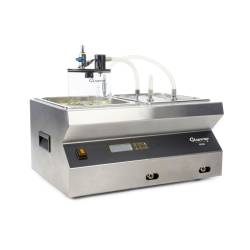DISTILLATION: LET'S MAKE IT CLEAR
Distillation in the kitchen
Distillation allows chefs to create incredible flavors to personalize their dishes by extracting aromatic elements, essences, alcohols and hydrolates, concentrating them through cold reduction in sauces, juices, broths and purees.
All of these reasons add up to a wide range of possibilities that make it possible to approach this technique-distillation-and thus develop specific equipment that fits the needs of the cook, pastry chef or ice cream maker, both in production and cost and in maintenance, and that also manages to make the process much easier.
The distillation of cocktails
Bartenders were the first to see new applications for their products. In this sense, Girovap also allows the redistillation of spirits to prepare unique and personal flavors and aromas with which to give cocktails the nuances of their creators.
Bitter and alcoholic beverages, the use of hydrolates in scale production, and the scenting of ice or cocktails are just some of the new techniques that bartenders have added to immediately take advantage of distillation and create a new era in cocktail production.
Limitations of using Rotovapor
The tool that chefs and bartenders use today is the 'Rotovapor,' a laboratory version that was not conceived or designed for the needs of the food&beverage world and, despite its high sophistication and high price, does not allow professionals to do everything they need to do.
The low tightness of the rotary steam system makes it difficult to determine and maintain an exact pressure throughout the process and forces us to work continuously and all the time with a vacuum pump in order to ensure a comfortable and constant level.
This system makes the useful life of this pressure equipment considerably shorter. This is not the case if they are designed to withstand vapors and alcohols, in which case we are already talking about high-end equipment with a high investment cost.
Also, on some equipment it is almost impossible to remove the contents from the glass bubble because of its narrow neck. Technically, this equipment is of a complexity and delicacy that makes it difficult to support the real needs of cooks.
The difficult cleaning, maintenance, and fragility of many of their parts make them suitable only for 'handymen'.
Differences between Girovap and Rotovapor
Conventional Rotovapors are complex and fragile machines designed for laboratory use. Therefore, when kitchen or cocktail bar professionals try to use them, they face drawbacks such as lack of vacuum power, their high price, their difficult maintenance, and their fragile materials. Girovap was born to put an end to all these drawbacks, as it was designed and built from the ground up for cooks and bartenders.
- Diaphragm diaphragm pump
Girovap is equipped with a double-diaphragm vacuum pump with suction of 15 liters per minute. Its two independent heads joined by a patented system allow it to achieve a vacuum level comparable to oil-bath vacuum pumps by guaranteeing -0.97 bar (Relative Pressure). Being a diaphragm pump, it does not require continuous maintenance, as its system allows moisture to escape.
2. Distillation vessel
Rotovapors have a glass in which the main ingredient is placed; this glass is called an 'Erlenmeyer flask.' In conventional equipment, its capacity is generally 2 liters. Rotating the product inside, to increase the evaporation area, limits its load to half.
Girovap's cylinders do not rotate, so they can be loaded to 75% of their actual capacity. Girovap runs up to 2.5 L in its 3-liter cup or up to 3.5 L in its 5-liter cup.
Whichever vacuum seal element rotates, no gaskets leak due to material wear given by rotation, so the vacuum level will always be the same.
Its lid has a probe that measures the exact steam temperature and a regulating tap to control the vacuum level. In addition, it can be used to introduce more liquid into the cup without interrupting the process.
3. Magnetic rotation system
One of the most innovative parts of Girovap, besides the flawless pump, is its rotation system that generates perfect temperature homogenization with all kinds of ingredients, if not the ability to generate a giant vortex to increase the maximum evaporation surface. Its powerful traction together with different attachments allows working with semi-solid ingredients. Its blades ensure a high degree of vacuum because, when working with floating products, the blades capture the foam, preventing it from escaping the chamber and entering the collection area.
Limitations of the classic Rotovapor:
- Small ampoule
- Narrow neck
- Unstable vacuum
- Higher vacuum temperature [Note: the lower it is, the purer the product you get]
- Has only one pump
- Bain-marie temperature is about 65°C
Differences with Girovap:
- It has a double diaphragm pump (NOT oil!)
- The water bath temperature is about 55°C, so it consumes less
- Its vessels are larger, to have more surface area in which to distill
Culinary experience and knowledge
Innovating tools and machines for the professional kitchen of the future is the vocation of 100% Chef, a company that has established itself through a wide and continuous offering of unique, handcrafted and designer products. In short, a symbol of solid experience and gastronomic knowledge for more than a decade.
The purpose of the creations that 100% Chef offers is to highlight and facilitate the daily work of kitchen and bar professionals, building a bridge between classic techniques and their need for updating, from a basic level of learning to the most advanced contemporary cooking techniques.
100% Chef creates its products from prototypes tested by the chefs themselves using materials that are resistant to heavy use and comply with high-quality international standards.
CONCLUSIONS
Using a machine such as Girovap, born from listening to the needs of chefs and bartenders, allows them to work better and more simply, containing start-up and maintenance costs, and also allowing them to experiment with new processing techniques.



